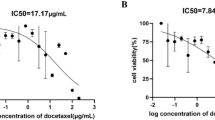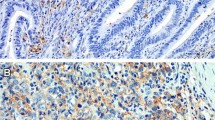Abstract
Immune checkpoint (ICP) molecules modulate the immune response by either inducing or preventing T cell activation. Over-expression of some ICPs on malignant cells has been shown to regulate anti-tumor immune responses. We aimed to investigate the expression levels of two immune checkpoint molecules which have not been studied extensively in patients with colorectal cancer (CRC). Programmed Death Ligand 2 (co-inhibitory) and 4-1BB ligand (co-stimulatory) were assessed in tumor tissues of CRC patients compared to the adjacent normal tissues. Following tissue excision during surgical operation from 21 CRC patients, RNA extraction, cDNA synthesis and semi-quantitative real-time PCR were done for measuring the expressions of PD-L2 and 4-1BBL genes. In protein level, indirect immunohistochemistery (IHC) was performed on tissue sections. We revealed that PD-L2 was expressed in about 81% CRCs and insignificantly correlated with the tumor differentiation grade. Although a 3.25-fold change in the gene expression of PD-L2 was found in tumor tissues compared to the adjacent normal tissues (P = 0.005), but decreased level of 4-1BBL in counterpart tissues was not significant. Our results were confirmed by IHC for PDL-2 (P = 0.02) and 4-1BBL, however it was not statistically significant for the latter one. Although not significant, we could find an association between the elevated expression of PD-L2 and the tumor differentiation grade. Increased expression of negative regulator of the anti-tumor immune responses like PD-L2, as a prominent way of tumor escape, can be considered for cancer immunotherapy approaches in CRC patients using blocking monoclonal antibodies.



Similar content being viewed by others
References
Arnold M, Sierra MS, Laversanne M, Soerjomataram I, Jemal A, Bray F (2016) Global patterns and trends in colorectal cancer incidence and mortality. Gut 66(4):683–691
Pourhoseingholi MA, Zali MR (2012) Colorectal cancer screening: time for action in Iran. World J Gastrointest Oncol 4(4):82–83
Azadeh S, Moghimi-Dehkordi B, Fatem S, Pourhoseingholi M, Ghiasi S, Zali M (2007) Colorectal cancer in Iran: an epidemiological study. Asian Pac J Cancer Prevent 9(1):123–126
Association AO (2000) Cecil textbook of medicine. WB Saunders Company, Philadelphia
Farkona S, Diamandis EP, Blasutig IM (2016) Cancer immunotherapy: the beginning of the end of cancer? BMC Med 14(1):73
Jacobs J, Smits E, Lardon F, Pauwels P, Deschoolmeester V (2015) Immune checkpoint modulation in colorectal cancer: what’s new and what to expect. J Immunol Res 2015:158038
Emambux S, Tachon G, Junca A, Tougeron D (2018) Results and challenges of immune checkpoint inhibitors in colorectal cancer. Expert Opin Biol Ther 18(5):561–573
Rozali EN, Hato SV, Robinson BW, Lake RA, Lesterhuis WJ (2012) Programmed death ligand 2 in cancer-induced immune suppression. Clin Dev Immunol 2012:656340
Ghiotto M, Gauthier L, Serriari N, Pastor S, Truneh A, Nunès JA et al (2010) PD-L1 and PD-L2 differ in their molecular mechanisms of interaction with PD-1. Int Immunol 22(8):651–660
Chemnitz JM, Parry RV, Nichols KE, June CH, Riley JL (2004) SHP-1 and SHP-2 associate with immunoreceptor tyrosine-based switch motif of programmed death 1 upon primary human T cell stimulation, but only receptor ligation prevents T cell activation. J Immunol 173(2):945–954
Guo P-D, Sun Z-W, Lai H-J, Yang J, Wu P-P, Guo Y-D et al (2018) clinicopathological analysis of PD-l2 expression in colorectal cancer. OncoTargets Ther 11:7635
Topalian SL, Drake CG, Pardoll DM (2012) Targeting the PD-1/B7-H1 (PD-L1) pathway to activate anti-tumor immunity. Curr Opin Immunol 24(2):207–212
Dong H, Strome SE, Salomao DR, Tamura H, Hirano F, Flies DB et al (2002) Tumor-associated B7–H1 promotes T-cell apoptosis: a potential mechanism of immune evasion. Nat Med 8(8):793
Yaghoubi N, Soltani A, Ghazvini K, Hassanian SM, Hashemy SI (2019) PD-1/PD-L1 blockade as a novel treatment for colorectal cancer. Biomed Pharmacother 110:312–318
Yearley JH, Gibson C, Yu N, Moon C, Murphy E, Juco J et al (2017) PD-L2 expression in human tumors: relevance to anti-PD-1 therapy in cancer. Clin Cancer Res 23(12):3158–3167
Bartkowiak T, Curran MA (2015) 4–1BB agonists: multi-potent potentiators of tumor immunity. Front Oncol 5:117
Vinay DS, Kwon BS (2014) 4–1BB (CD137), an inducible costimulatory receptor, as a specific target for cancer therapy. BMB Rep 47(3):122–129
Wang Q, Zhang P, Zhang Q, Wang X, Li J, Ma C et al (2008) Analysis of CD137 and CD137L expression in human primary tumor tissues. Croat Med J 49(2):192–200
Dimberg J, Hugander A, Wågsäter D (2006) Expression of CD137 and CD137 ligand in colorectal cancer patients. Oncol Rep 15(5):1197–1200
Croft M (2003) Co-stimulatory members of the TNFR family: keys to effective T-cell immunity? Nat Rev Immunol 3(8):609
Anderson MW, Zhao S, Freud AG, Czerwinski DK, Kohrt H, Alizadeh AA et al (2012) CD137 is expressed in follicular dendritic cell tumors and in classical Hodgkin and T-cell lymphomas: diagnostic and therapeutic implications. Am J Pathol 181(3):795–803
Chester C, Ambulkar S, Kohrt HE (2016) 4–1BB agonism: adding the accelerator to cancer immunotherapy. Cancer Immunol Immunother 65(10):1243–1248
Liao H, Chen W, Dai Y, Richardson JJ, Guo J, Yuan K et al (2019) Expression of programmed cell death-ligands in hepatocellular carcinoma: correlation with immune microenvironment and survival outcomes. Front Oncol 9:883
Carreno BM, Collins M (2002) The B7 family of ligands and its receptors: new pathways for costimulation and inhibition of immune responses. Annu Rev Immunol 20(1):29–53
Kwon B, Kim B-S, Cho HR, Park J-E, Kwon BS (2003) Involvement of tumor necrosis factor receptor superfamily (TNFRSF) members in the pathogenesis of inflammatory diseases. Exp Mol Med 35(1):8
Salih H, Kiener P, Nüssler V (2002) 4–1 BB ligand–just another costimulating molecule? Int J Clin Pharmacol Ther 40(8):348–353
Salih HR, Schmetzer HM, Burke C, Starling GC, Dunn R, Pelka-Fleischer R et al (2001) Soluble CD137 (4–1BB) ligand is released following leukocyte activation and is found in sera of patients with hematological malignancies. J Immunol 167(7):4059–4066
Wang H, Yao H, Li C, Liang L, Zhang Y, Shi H et al (2017) PD-L2 expression in colorectal cancer: independent prognostic effect and targetability by deglycosylation. Oncoimmunology 6(7):e1327494
Hamanishi J, Mandai M, Iwasaki M, Okazaki T, Tanaka Y, Yamaguchi K et al (2007) Programmed cell death 1 ligand 1 and tumor-infiltrating CD8+ T lymphocytes are prognostic factors of human ovarian cancer. Proc Natl Acad Sci 104(9):3360–3365
Gao Q, Wang X-Y, Qiu S-J, Yamato I, Sho M, Nakajima Y et al (2009) Overexpression of PD-L1 significantly associates with tumor aggressiveness and postoperative recurrence in human hepatocellular carcinoma. Clin Cancer Res 15(3):971–979
Nomi T, Sho M, Akahori T, Hamada K, Kubo A, Kanehiro H et al (2007) Clinical significance and therapeutic potential of the programmed death-1 ligand/programmed death-1 pathway in human pancreatic cancer. Clin Cancer Res 13(7):2151–2157
Valentini AM, Di Pinto F, Cariola F, Guerra V, Giannelli G, Caruso ML et al (2018) PD-L1 expression in colorectal cancer defines three subsets of tumor immune microenvironments. Oncotarget 9(9):8584
Nirschl CJ, Drake CG (2013) Molecular pathways: co-expression of immune checkpoint molecules: signaling pathways and implications for cancer immunotherapy. Clin Cancer Res 19(18):4719–4724
Schmid P, Hegde PS, Zou W, Kowanetz M, Mariathasan S, Molinero L et al (2016) Association of PD-L2 expression in human tumors with atezolizumab activity. American Society of Clinical Oncology, Chicago
Zhang Y, Chung Y, Bishop C, Daugherty B, Chute H, Holst P et al (2006) Regulation of T cell activation and tolerance by PDL2. Proc Natl Acad Sci 103(31):11695–11700
Shao Z, Schwarz H (2011) CD137 ligand, a member of the tumor necrosis factor family, regulates immune responses via reverse signal transduction. J Leukoc Biol 89(1):21–29
Segal NH, He AR, Doi T, Levy R, Bhatia S, Pishvaian MJ, et al (2018) Phase I study of single-agent utomilumab (PF-05082566), a 4–1BB/CD137 agonist, in patients with advanced cancer. Clin Cancer Res 24(8):1816–23
Acknowledgements
We would like to thank Samaneh Tokhan Beigi for her technical assistant and Dr. Behboo and Dr. Farzaneh Niknafs for collecting the samples. Also, we would like to appreciate all the patients who participated in this study. This work was supported by the Gastroenterology and Liver Diseases Research center, Research institute for Gastroenterology and Liver Diseases, Shahid Beheshti University of Medical Sciences, Tehran, Iran
Funding
Semnan University of Medical Science (code:1134).
Author information
Authors and Affiliations
Corresponding author
Ethics declarations
Conflict of interest
The authors declare that they have no conflict of interest.
Informed consent
Informed consent was obtained from all individual participants included in the study.
Additional information
Publisher's Note
Springer Nature remains neutral with regard to jurisdictional claims in published maps and institutional affiliations.
Rights and permissions
About this article
Cite this article
Shakerin, P., Sedighi Moghadam, B., Baghaei, K. et al. Increasing the expression of programmed death ligand 2 (PD-L2) but not 4-1BB ligand in colorectal cancer cells. Mol Biol Rep 47, 5689–5697 (2020). https://doi.org/10.1007/s11033-020-05289-7
Received:
Accepted:
Published:
Issue Date:
DOI: https://doi.org/10.1007/s11033-020-05289-7




